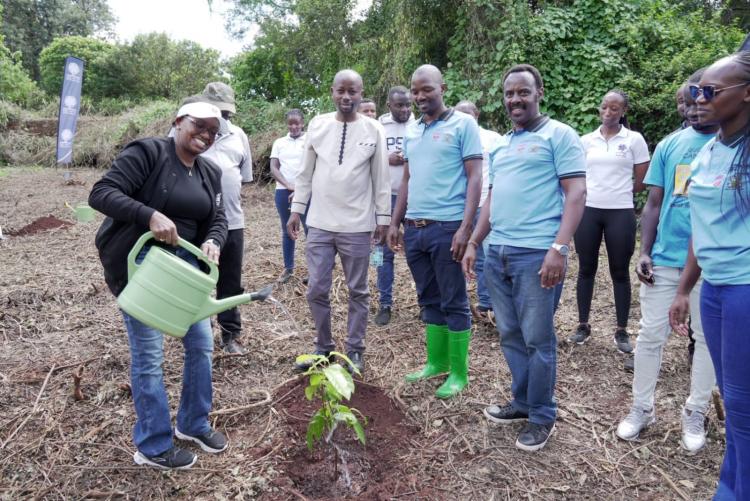In a significant step toward environmental restoration, Viva 365 Insurance Brokers planted 20 indigenous trees at the Wangari Maathai Institute for Peace and Environmental Studies (WMI) on May 17, 2025. The event marked Viva's adoption of a half-acre meditation site as part of the Landscape Repair and Transformation project (LANSRET), with a three-year commitment to maintain the area. This partnership addresses the challenge of invasive species that have threatened the institute's gardens.
The event brought together representatives from Viva Insurance, Hearts of Green organization, WMI faculty members, and students in a collaborative effort to transform degraded land. The site, once overrun by invasive species like Lantana camara and Black Wattle trees, is being reclaimed through their collective efforts to create a meditation area that aligns with Professor Wangari Maathai's vision.
"The impact you're bringing is a legacy, something we are doing for even other generations that are going to benefit," said Emmaculate Cheptoo, Managing Director at Viva 365 Insurance Brokers. "It's the little thing we do. If that little hummingbird is able to carry small water, we feel like we are contributing meaningfully."
The hummingbird reference echoes one of Wangari Maathai's favorite stories about doing what you can, no matter how small. As Professor Thuita Thenya, Director of the Wangari Maathai Institute, explained during the event, "The story of the hummingbird is that it's a small bird and when the forest is on fire, it's the only one that decides that 'I'm going to put out the fire.' Yet, her beak can only carry a drop of water. But it's not discouraged by what it's actually doing."
Professor Kahonge, Chair of the Department of Computer Science, delivered remarks on behalf of Dean Professor Kerubo, emphasizing WMI's significance as one of 11 institutes at the University of Nairobi. He highlighted how the institute honors Africa's first woman Nobel laureate and UoN alumni who, despite her high education, chose to work with grassroots women to address environmental degradation. "Her courage has continued to inspire many people across the globe, especially on society transformation ideas like linking governance, human and environmental rights, and peace. Our actions must mirror this courage and contribute to society empowerment and outreach services today," he stated, underscoring the importance of strategic partnerships like those with Hearts of Green and Viva Insurance Brokers.
This philosophy underpins the entire restoration project. Viva Insurance has committed to maintaining the adopted site for three years through the Landscape Repair and Transformation project (LANSRET), working in partnership with Hearts of Green and WMI.
The institute itself stands as a testament to Maathai's vision. Conceived by her between 2008 and 2011 before her passing, the institute was designed to embody principles of sustainability, peace, and environmental conservation. The building incorporates African colors, natural lighting, water infiltration systems, and natural cooling mechanisms—all reflecting Maathai's emphasis on blending tradition with sustainability.
Moses Muya, Executive Director of Hearts of Green, emphasized the importance of science-based approaches to conservation. "Previously we were just announcing numbers, we've planted 20,000, 50,000, but when we went back after some time, we find there's none. So we asked ourselves, yes, we are very aggressive in talking so much, but there's no sense, we were not quoting science."
The partnership with WMI brings academic rigor to their conservation efforts. Together, they are implementing the Landscape Repair and Transformation program to restore degraded areas and create a better world for current and future generations.
The half-acre site adopted by Viva Insurance was originally planned as a meditation area within WMI's 50-acre campus. The restoration involves removing invasive species and planting 20 endangered indigenous tree species, including Prunus africana, Mugumo, Teclea nobilis, Meru oak, and Cordia africana.
Professor Thenya further highlighted the persistent challenge posed by invasive species. Lantana camara, introduced in the 1950s as an ornamental plant from South Africa, forms dense thickets that displace native vegetation and is considered one of the most problematic invasive plants in Africa. The Black Wattle tree, introduced in the late 1800s from Australia, competes for nutrients and light, with seeds that can remain viable for over a century."Viva's commitment to adopt half an acre and maintain it for three years through the LANSRET project is greatly appreciated," noted the Prof. Thenya. "The site will realize its intended objective as a meditation area, contributing to human wellbeing while serving as a demonstration and learning platform."
The Managing Director further affirmed Viva's commitment to sustainability: "We promised to walk the journey. We do not want to do a one-stop solution. We do not just want to dash our shipworks in terms of sustainability, and we challenge each other with hope that soon we'll set up a program where we can come here and learn something."
The restoration initiative aligns perfectly with one of Wangari Maathai's most quoted statements: "You can make a lot of speeches, but the real thing is when you dig a hole, plant a tree, give it water, and make it survive. That's what makes the difference."
Through this partnership between corporate sponsors, environmental organizations, and academic institutions, Wangari Maathai's legacy continues to grow, ONE TREE AT A TIME!

